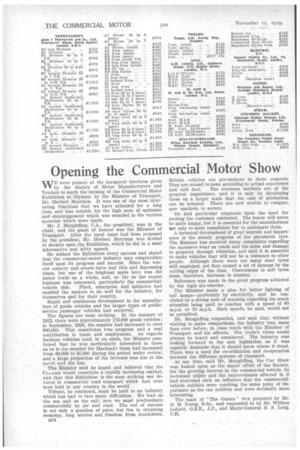Opening the Commercial Motor Show
Page 192

If you've noticed an error in this article please click here to report it so we can fix it.
WE were present at the inaugural luncheon given by the Society of Motor Manufacturers and Traders to mark the opening of the Commercial Motor Exhibition at Olympia by the Minister of Transport, Mr. Herbert Morrison. It was one of the most interesting functions that we have attended for a long time, and was notable for the high note of optimism and encouragement which was sounded in the various speeches which were made.
Mr. J. Maughtling, C.A., the president, was in the chair, and the guest of honour was the Minister of Transport. After the loyal toast had been proposed by the president, Mr. Herbert Morrison was invited to declare open the Exhibition, which he did in a most informative and witty speech.
He wished the Exhibition every success and stated that the commercial-motor industry may congratulate itself upon its progress and success. Since the war, our country and others have had thin and depressing times, but one of the brightest spots here was the motor trade as a whole, and, so far as the export business was concerned, particularly the commercial vehicle side. Pluck, enterprise and initiative had enabled the makers to do well for the industry, for themselves and for their country.
Rapid and continuous development in the manufacture of goods vehicles and the larger types of publicservice passenger vehicles had occurred.
The figures are most' striking. In the summer of 1923, there were approximately 173,000 goods vehicles ; in September, 1928, the number had increased to over 300,000. This constitutes true progress and a real contribution to trade and employment. As regards hackney vehicles (and, in an aside, the Minister mentioned that he was particularly interested in these as he is the member for Hackney) these had increased from 86,000 to 95,000 during the period under review. and a large proportion of the increase was due to the conch and the bus.
" The Minister said he hoped and believed that the Co,onies would constitute a rapidly increasing market. and that this Exhibition is the most striking one devoted to commercial road transport which had ever been held in any country in the world.
Tribute, he continued, Must be paid to an industry which has had to face many difficulties. We lead on the sea and on the rail; now we must predominate commercially by air and road. The test of success is not only a question of price, but lies in obtaining economy, long service and freedom from breakdown.
1154 British vehicles are pre-eminent in these respects. They are second to none according to actual experience and cold fact. The overseas 1narkets are of the greatest importance, and it is only by developing these on a larger scale that the cost of production can be lowered. There are new worlds to conquer, new markets to secure.
He laid particular emphasis upon the need for making the customer contented. The buyer will never be quite happy, but it is essential for the manufacturer mot only to meet complaints but to anticipate them.
A technical development of great interest and importance is the steady progress of the pneumatic tyre.
The Minister has received many complaints regarding the excessive wear on roads and the noise and damage to property through vibration, and said it is essential to make vehicles that will not be a nuisance to other people. Although there were not many steel tyres still employed, yet they caused a lot of damage by the cutting edges of the rims. Conversions to soft tyres must, therefore, increase in number.
Reference was made to the great progress achieved by tile rigid six-wheeler.
The Minister made a plea for better lighting of tail lamps—preferably by electricity, and he con cluded by a strong note of warning regarding too much attention being paid to coaches with a speed of €9 m.p.h. or 70 m.p.h. Such speeds, he said, would not be permitted.
Mr. Maughfling responded, and said that, without wishing to make comparisons, the industry was, more than ever before, in close touch with the Minister of Transport and his officers. The trade's views would always be heard and considered. The industry was looking forward to the new legislation, as it was urgently desirable that it should know where it stood. There was a need for co-ordination and co-operation between the different systems of transport.
At one time, said Mr. Maughfling, the Car Show was looked upon as the major effort of the Society, but the growing interest in the commercial vehicle, its increased utility and the improvements effected in it had exercised such an influence that the commercial vehicle exhibits were reaching the same point of importance as the car exhibits and were decidedly more interesting.
The toast of "Tile Guests" wes proposed by Mr. G. M. Young, B.Sc., and responded to by Sir William Lob,joit, 0.B.E., J.P., and Major-General S. S. Long,








































































































































































































































































































































